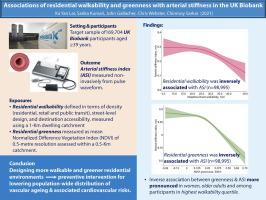Environment International ( IF 11.8 ) Pub Date : 2021-10-30 , DOI: 10.1016/j.envint.2021.106960 Ka Yan Lai 1 , Sarika Kumari 1 , John Gallacher 2 , Chris Webster 1 , Chinmoy Sarkar 3

|
Background
Arterial stiffness is a key non-invasive marker of early vascular ageing, however, little is known of its associations with urban built environment. We examined the associations of objectively-measured residential walkability and greenness with arterial stiffness in a large UK-wide population cohort.
Methods
We employed data from the baseline UK Biobank cohort comprising adult participants recruited over the period of 2006 to 2010. Residential walkability index, defined as a function of density (residential, retail and public transit), street-level design, and destination accessibility was measured using a 1-Km dwelling catchment, while greenness was modelled as the mean Normalized Difference Vegetation Index (NDVI) of 0.5-metre resolution assessed within a 0.5-Km catchment. Arterial stiffness index (ASI) was measured non-invasively from the pulse waveform. Linear regression models were developed to examine associations of walkability and greenness with arterial stiffness. Restricted cubic spline (RCS) models were developed to examine dose–response relationships. We also examined effect modifications by sex and age, as well as the interaction effect of greenness and walkability.
Results
This cross-sectional study used a target sample of 169,704 UK Biobank participants aged ≥ 39 years. After full adjustments, in reference to the lowest walkability exposure quartile, those in the highest were associated with lower ASI (β = −0.083 m/s, 95% CI: −0.14 to −0.03, p = 0.005). Participants in the third and fourth NDVI greenness exposure quartiles were also associated with lower ASI (β = −0.074 m/s, −0.14 to −0.01, p < 0.020 for the third and β = −0.293 m/s, −0.36 to −0.23, p < 0.001 for the fourth quartiles in reference to the first). The inverse association between NDVI greenness and ASI was more pronounced among women (p < 0.001), older adults (p = 0.011) and among participants in the highest walkability quartile (p < 0.001).
Conclusion
Designing more walkable and greener residential environments can be a preventive intervention aimed at lowering the population distribution of vascular ageing and associated cardiovascular risks.
中文翻译:

英国生物库中住宅步行性和绿色与动脉僵硬度的关联
背景
动脉僵硬度是早期血管老化的关键非侵入性标志物,然而,人们对其与城市建筑环境的关联知之甚少。我们在一个全英国的大型人口队列中检查了客观测量的住宅步行性和绿色与动脉僵硬度的关系。
方法
我们使用了来自英国生物银行基线队列的数据,该队列由 2006 年至 2010 年期间招募的成年参与者组成。住宅步行指数,定义为密度(住宅、零售和公共交通)、街道设计和目的地可达性的函数。使用 1 公里的住宅集水区,而绿度被建模为在 0.5 公里的集水区内评估的 0.5 米分辨率的平均归一化植被指数 (NDVI)。从脉搏波形无创地测量动脉僵硬度指数 (ASI)。开发了线性回归模型来检查步行性和绿色与动脉僵硬度的关系。开发了受限三次样条 (RCS) 模型来检查剂量-反应关系。我们还检查了性别和年龄的效果修改,
结果
这项横断面研究使用了 169,704 名年龄 ≥ 39 岁的英国生物银行参与者的目标样本。完全调整后,参考最低的步行暴露四分位数,最高的那些与较低的 ASI 相关(β = -0.083 m/s,95% CI:-0.14 至 -0.03,p = 0.005)。第三和第四个 NDVI 绿色暴露四分位数的参与者也与较低的 ASI 相关(β = -0.074 m/s,-0.14 到 -0.01,第三个和 β = -0.293 m/s,-0.36 到 - 0.23, p < 0.001 对于第四个四分位数参考第一个)。NDVI 绿度与 ASI 之间的负相关在女性 (p < 0.001)、老年人 (p = 0.011) 和最高步行四分位数的参与者 (p < 0.001) 中更为明显。
结论
设计更适合步行和更环保的居住环境可以作为一种预防性干预措施,旨在降低血管老化和相关心血管风险的人口分布。



























 京公网安备 11010802027423号
京公网安备 11010802027423号